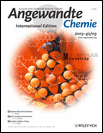Cover Picture: Molecular Mousetraps: Gas-Phase Studies of the Covalent Coupling of Noncovalent Complexes Initiated by Reactive Carbenes Formed by Controlled Activation of Diazo Precursors (Angew. Chem. Int. Ed. 9/2003)
Abstract
Molecular mousetraps are an unprecedented class of host–guest reagents. In the example shown in the cover picture, 18-crown-6 ether is utilized as the “bait” to attract target molecules with a protonated primary amine functional group. Appropriate activation of the noncovalent complex springs the diazo “trap”, which leads to covalent attachment of the two molecules depicted in the reaction scheme. The research is detailed in the Communication by J. L. Beauchamp, B. M. Stoltz et al. on page 1012 ff.




